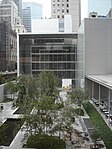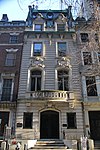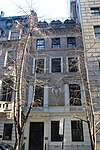Rockefeller Apartments

The Rockefeller Apartments is a residential building at 17 West 54th Street and 24 West 55th Street in the Midtown Manhattan neighborhood of New York City. Designed by Wallace Harrison and J. André Fouilhoux in the International Style, the Rockefeller Apartments was constructed between 1935 and 1936. The complex was originally designed with 138 apartments. The apartment complex, just north of the Museum of Modern Art, was built on land left over from the construction of Rockefeller Center. The Rockefeller Apartments consists of two towers, one facing north toward 55th Street and one facing south toward 54th Street. The land under the Rockefeller Apartments had been owned by the Rockefeller family, and the architects had been involved in designing Rockefeller Center. The two towers are 11 stories and are faced with brick, with partially protruding cylindrical bays. The interior was intended to allow fifteen percent more air and natural light compared to contemporary building regulations. The ground floor contains a location of Michael's Restaurant. The Rockefeller family had secretly acquired the site by the 1930s, although this was not disclosed until the plans for the apartment complex were announced in November 1935. The family had intended to remodel existing houses on the site, though they instead decided to build an apartment complex to complement Rockefeller Center, connected via an ultimately unbuilt extension of Rockefeller Plaza. The complex was fully leased by the time residents moved to the apartments in October 1936. The building was sold to the Astor family in 1945 and Henry Goelet in 1953, and it became a cooperative apartment complex in 1954. The New York City Landmarks Preservation Commission designated the complex as a city landmark in 1984.
Excerpt from the Wikipedia article Rockefeller Apartments (License: CC BY-SA 3.0, Authors, Images).Rockefeller Apartments
West 55th Street, New York Manhattan
Geographical coordinates (GPS) Address External links Nearby Places Show on map
Geographical coordinates (GPS)
| Latitude | Longitude |
|---|---|
| N 40.76195 ° | E -73.97654 ° |
Address
West 55th Street 24
10019 New York, Manhattan
New York, United States
Open on Google Maps







